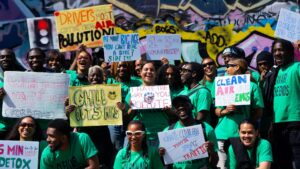Air Quality News editor Chloe Coules speaks to Professor Prashant Kumar, Founding Director of the Global Centre for Clean Air Research (GCARE) at the University of Surrey, about his career in air quality research.
Professor Prashant Kumar’s interest in air quality began while studying for his master’s degree in Delhi, India.
‘As part of my dissertation, I picked up the topic of air quality, looking into the respirable suspended particulate matter in and around Delhi,’ he tells Air Quality News.
‘That gave me the motivation that this is a problem, but back then in 2003 when I was doing this work, there was not a lot of awareness about air pollution, and people were taking air quality for granted.’
As awareness of air quality has grown, so has Professor Kumar’s career. Now Associate Dean for the Faculty of Engineering and Physical Sciences and Professor and Chair in Air Quality at the University of Surrey, he has over 210 articles in top-ranked journals and works with collaborators across four continents.
He also founded the Global Centre for Clean Air Research (GCARE), a world renowned, multi-disciplinary centre focused on improving indoor and outdoor air quality.
‘The idea was to understand the impact of air pollutants on life quality, developing internationally validated engineering solutions and underpinning regulatory strategies,’ explains Prashant.
In his time as Director, GCARE has secured over £8m in research funding, completed over 40 projects and produced over 300 journal articles in the air quality space.
Professor Kumar tells Air Quality News that his varied background in civil and environmental engineering has allowed him to understand the importance of taking multi-disciplinary approaches to tackle air pollution.
‘The problem of air quality is not something that a person with one discipline could really solve. For example, you might need to have an understanding of physics to understand how these particles are physically moving into the environment, you need to understand chemistry in terms of how the particles are interacting with each other, you need to understand the engineering side so that you can model them and bring some kind of mathematical background into it.
‘My background allows me to tackle this problem from a very multi-disciplinary perspective. I can think from a holistic point of view, rather than just focusing on one aspect. This is where my research is a little bit distinctive from what a lot of people are doing.’
Professor Kumar’s team at GCARE is made up of researchers from a wide range of fields, including physics, chemistry, biochemistry and mathematics, as well as civil, chemical and mechanical engineers, and even people with a background in English language and social science to help communicate the research.
‘Air quality is an area for everyone who is interested in it; everyone has got something to contribute to it,’ says Prashant.
The work of GCARE falls into three strands: fundamental research, applied research and community-driven research. Their fundamental research attempts to improve understanding of air pollution and tackle grey areas in the research, and then the applied strand turns this understanding into solutions to air quality issues.
For example, GCARE worked with Global Action Plan and the engineering company Arup to improve air quality for children and teachers at five schools in London through the Lambeth Schools Air Quality Project that run from 2020 to 2021.
The CArE-Cities project in 2019-2020 also established a multidisciplinary team for understanding emissions, penetrating low-cost pollution monitoring technology and exposure reduction strategies in selected official development assistance countries to develop a scientific framework for managing air pollution impacts on the health of people in these cities.
It assessed commuters’ exposure through collecting primary air pollution data and evaluated different control scenarios to propose optimal transport emission control programmes to reduce the impact of air pollution on human health in Cairo and Sao Paulo, assessing the feasibility of similar studies in countries such as Malawi, Tanzania, Iraq, Bangladesh and Ethiopia.
He says that one of the highlights of his work at GCARE has been establishing the Guildford Living Lab, which works closely with the local community and produces free public resources that provide simple measures that individuals can take to improve air quality based on scientific evidence.
He also thinks a strength of their work has been building global connections to tackle air pollution: ‘As the name suggests, we have had over 40 countries involved very actively through different projects and different solutions that we have been creating. Having a very good network globally has allowed us to not only understand the problem in the UK, but also overseas, and work together with [other countries] to make a bigger impact.’
Professor Kumar has also recently launched the RECLAIM Network on 6 May, which aims to be a ‘one stop shop’ for towns and cities to find the information and support they need to install green and blue infrastructure in their communities.
Prashant explains that when moving towards net zero and looking to make cities more sustainable, green and blue infrastructure have an important part to play, in terms of reducing air pollution, improving human health and increasing biodiversity.
However, he has noticed a lack of research explaining how to incorporate these natural solutions into climate and clean air strategies.
‘One of the issues I have seen through the research we have done into this area is there is a lack of clear guidance on where you want to put a tree, what trees you want to put in, and how you can benefit the most from these deployments.
‘In some cases, you might deploy infrastructure that could lead to the deterioration of the air quality of bring negative impacts to the area if you do not think more carefully about it. So, what we wanted to do is bring the councils as well as researchers and businesses together and try to come up with solutions that are simple, effective and deployable.’
This article first appeared in the May issue of Air Quality News – view it in full here.
















Leave a Reply